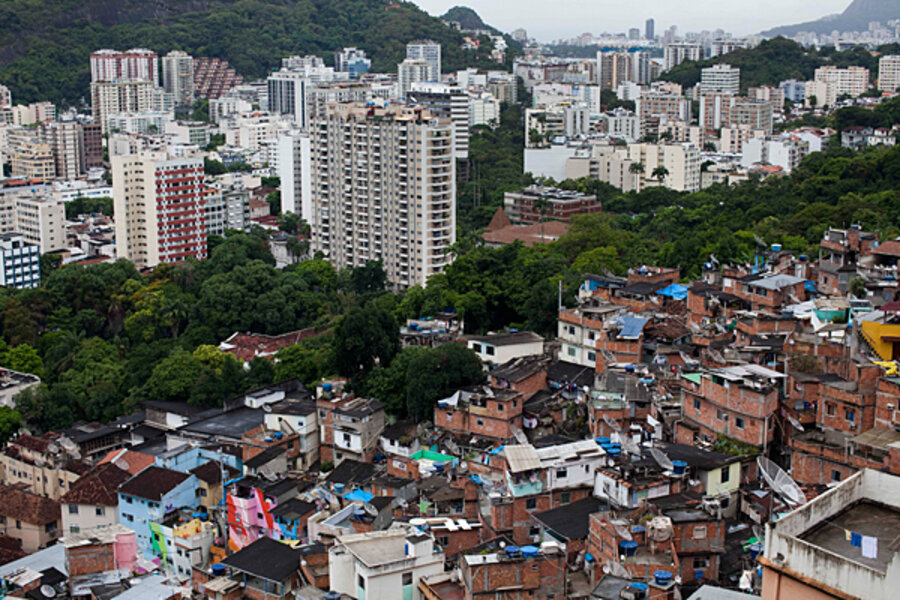Rio's shantytowns shrink – on Google Maps, at least
Loading...
| Rio de Janeiro
Google’s decision this week to dramatically amend its map of future World Cup and Olympics host Rio de Janeiro boils down to one person: the wife of a newspaper editor who was trying to find a shop.
While Rio’s tourism officials complained as early as 2009 that Google Maps exaggerated the size of the city’s slums, it wasn’t until the main daily newspaper O Globo took on the topic that Google actually responded.
The weekend article in O Globo – “Google Maps turns Rio into an agglomeration of favelas” – noted that the size of letters to indicate favelas (shantytowns) was often the same as those for the larger, wealthier neighborhoods they bordered. By Tuesday, the paper reported that Google had agreed to change its maps within the year.
It's one of many diplomatic disputes worldwide over Google's online maps, but the new agreement to prioritize Rio's wealthy neighborhoods and tourist points is opening the search engine to complaints that it is bowing to media and commercial pressure.
"From my perspective, what’s happening is Rio is asking the map to be remade so people coming in for the World Cup and Olympics won’t think it’s a city of slums," says Jason Farman, professor of American Studies at the University of Maryland and the author of “Mapping the Digital Empire,” which looks at the impacts of social media on global borders. "[They] want to minimize the poor and delineate them into a smaller space on the map."
Google Maps' many international flare-ups
This was not the first flare-up over Google’s online maps. In November, Costa Rica complained after Nicaraguan officials used Google Maps to claim disputed territory. Early last year, Cambodia said Google Earth was "devoid of truth and reality” in placing part of a contentious temple in Thailand. Google has attempted to placate India and China by placing the disputed region of Arunachal Pradesh in each nation – depending on where you log into Google.
And it’s not just developing nations, which often lack the resources to properly survey and demarcate their borders, that are crying foul. Earlier this year, the northwest German town of Emden complained that Google Maps gave its harbor to the Netherlands. In July, Spain complained that Google wrongly gave Morocco the Isla de Perejil.
But this is almost certainly the first time that a woman’s stymied search for a retail store set off a chain of events rippling all the way to the California headquarters of the world’s largest Internet search engine.
“We decided to do the piece after the wife of an editor here in the office had made a prosaic search in Google – to locate some commercial establishment – from home [and] became surprised with the high number of favelas indicated, even the majority unfamiliar ones,” Laura Antunes, who wrote the story, told the Monitor in an e-mail. “She commented with her husband... [and] from this case the topic came out."
Maps and social values
Maps reveal much about social values, says Mr. Farman.
"Maps are not just about accuracy, they're always about choices we make as human beings to represent our spaces," he says. "What prompted [Google's decision to on Rio mapping] is issues that center around consumerism and commerce and the news media."
"The power in being able to decide, and to side with certain government entities, it kind of puts Google on par with our previous understanding of the role that nations played," says Farman. "The ways that we think about what and who is powerful in the world needs to change."
But tourism operators here say that visitors – especially foreigners – are keen on seeing the favelas.
“Tourists like it. They always come to ask for this,” João Luiz says as he points to his favela tourism sign, next to another offering one to visit Rio’s samba stadium, Sugarloaf Mountain, and botanical gardens.
“You know which tourist does this [favela] tour more? The foreigners, not the Brazilians,” he adds.
Sergio Defrayer and Alessandro Adão are government-employed tourist guides at the base of the favela Dona Marta, which is touted as a model “pacified” community freed from drug traffickers by a new policing program. They encourage tourists to visit the favela’s plaza, which has a mural and statue of Michael Jackson to commemorate a video he filmed there.
Mr. Defrayer says that tourists have been coming to Dona Marta to see where Vin Diesel filmed the upcoming “Fast and the Furious 5.”
Google “needs to show everything [to promote tourism], not just favelas but also the Zona Sul [asphalt neighborhoods],” says Mr. Adão.
Lounging at the top of the Dona Marta hill in the evening, Edmaldo Faria says it’s fine by him if favelas like his are diminished on Google. The current map has “a positive and a negative side [since] it serves as a notice for a tourist” to not accidentally happen upon one, he says.
“There’s going to be complaints, surely,” when Google changes it, he adds. “You can’t please everybody.”
(With additional reporting by Stephen Kurczy in Boston.)





